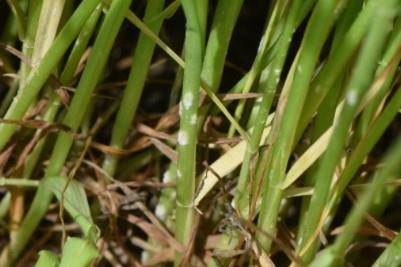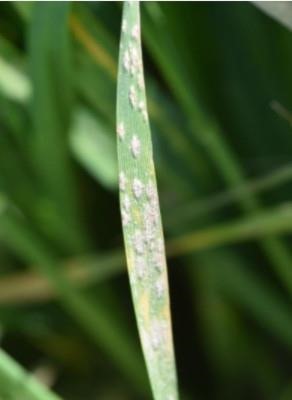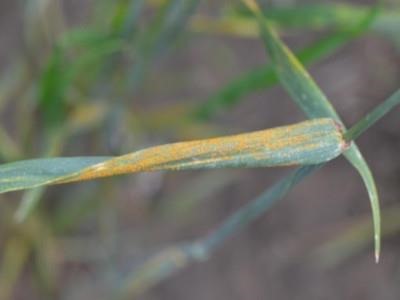By Stephen Wegulo
Despite the recent spell of cool temperatures which somewhat slowed down wheat development in Nebraska, growth of the wheat crop is advancing and will continue to do so as temperatures warm up.

Figure 2. Powdery mildew on stems in the lower canopy in research plots at Havelock Farm on April 27.

Figure 3. Powdery mildew on a leaf in the lower canopy in research plots at Havelock Farm on April 27.
At the Havelock Farm in Lincoln, Lancaster County, on April 27, wheat in research plots was at growth stage Feekes 7 (second node palpable) and looked healthy with a luxuriant green canopy (Figure 1). However, examination of the lower and mid-canopy revealed two diseases in their early stages of development. Powdery mildew was present in the lower canopy on stems (Figure 2) and leaves (Figure 3). Septoria tritici blotch was also present in the lower (Figure 4) and mid canopy (Figure 5).
The presence of diseases in their early stages of development in research plots indicates that it is time to scout Nebraska wheat fields for early disease detection. There have been reports of high incidence and severity of stripe rust in Oklahoma. Stripe rust has been confirmed in southeastern Kansas and is likely to spread northward towards Nebraska. The disease is recognized by the orange-yellow stripes it forms on mature leaves (Figure 6). The stripes consist of fungal spores in pustules arranged parallel to the leaf veins. On young leaves, pustules do not form stripes (Figure 7).
Scout wheat fields regularly starting early in the growing season. To get an accurate assessment of the diseases present and their levels, scout a representative area of the field by using one of several patterns to walk through the field. Some patterns that are frequently used are X, W and Z. During the process, make frequent stops and examine plants for disease symptoms in the upper, mid and lower canopies.
If foliar fungal diseases are confirmed during scouting, be prepared to apply a fungicide to protect the flag leaf if weather conditions favor development of damaging levels of disease. Foliar fungal diseases of wheat are favored by moisture from rainfall or irrigation and high humidity. Table 1, prepared by the North Central Regional Committee on Management of Small Grain Diseases (NCERA-184), lists fungicides registered for use on wheat and their efficacies in controlling the various fungal diseases that occur on wheat.

Figure 4. Septoria tritici blotch in the lower canopy in research plots at Havelock Farm on April 27. Note the black pycnidia (asexual fruiting structures) in the old lesion.

Figure 5. Septoria tritici blotch in the mid canopy in research plots at Havelock Farm on April 27.

Figure 6. Stripe rust on a wheat flag leaf.

Figure 7. Stripe rust on a young wheat leaf.
Source : unl.edu